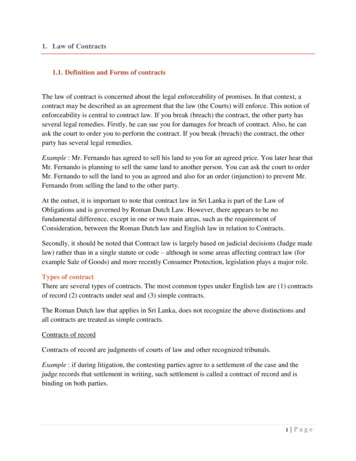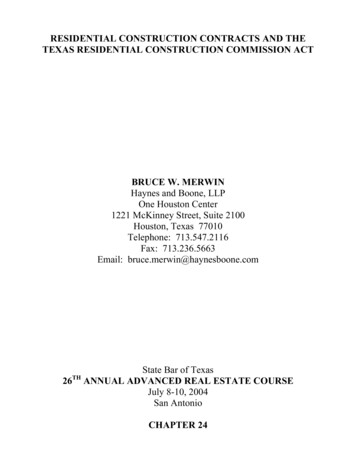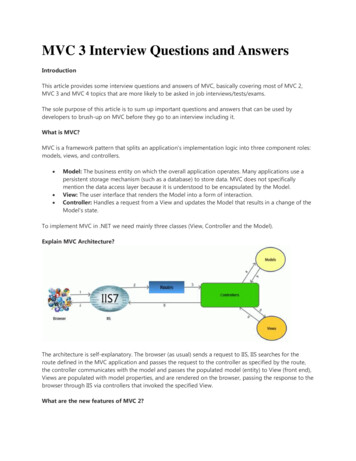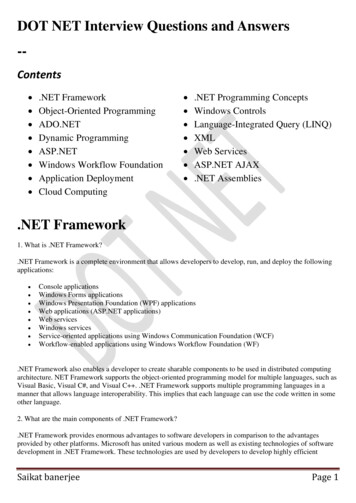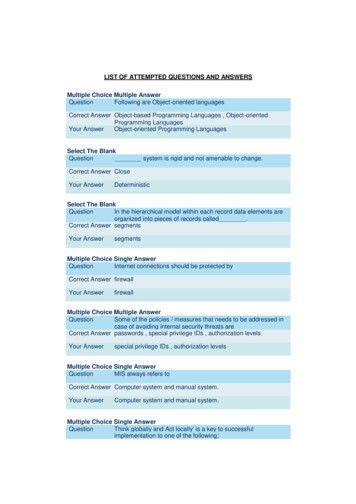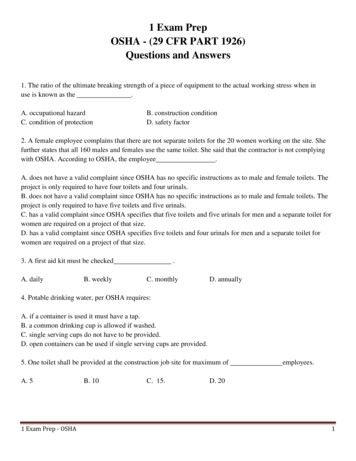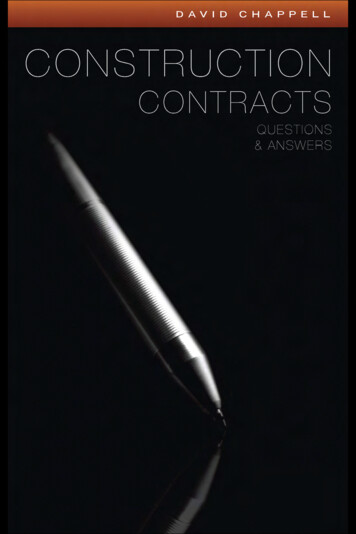
Transcription
Construction Contracts,Questions and AnswersConstruction law is sometimes simple and at other times complex.Professionals need answers that are pithy and straightforward but alsolegally rigorous.A number of questions come up time and again. They range incontent from extensions of time, liquidated damages and loss and/orexpense to issues of practical completion, defects, valuation, certificates and payment, architects’ instructions, adjudication and fees.Some questions are relatively simple, such as ‘what date should beput on a contract?’, but there are implications to even the simplestquestions. More elaborate ones might involve whether the contractor is entitled to take possession of a section of the work eventhough it is the contractor’s fault that possession is not practicable.David Chappell is well known as an architect, lecturer and writeron construction law. He has served for many years as SpecialistAdviser to the Royal Institute of British Architects, and this experience has given rise to this book. All the questions set out here are realones; and although most were originally asked by architects, theiranswers will be of wide interest to QSs, project managers, contractors, employers and others engaged in construction.David Chappell is director of David Chappell Consultancy Limitedand sometime Visiting Professor of Practice Management and Law atthe University of Central England in Birmingham. He has writtenmany articles and books for the construction industry, includingSpon’s Understanding JCT Standard Building Contracts, now in its7th edition. He frequently acts as an adjudicator.
Also available from Taylor & FrancisUnderstanding JCT Standard Building Contracts7th editionD. ChappellConstruction ContractsLaw and management4th editionJ. Murdoch and W. HughesDevelopment and the LawA guide for construction and property professionalsG. Bruce-RadcliffeDictionary of Property and Construction LawR. Hardy-PickeringThe Presentation and Settlement of Contractors’ Claims2nd editionM. Hackett and G.TrickeyFor price availability and ordering visit our websitewww.sponpress.comAlternatively our books are available from all good bookshops.
Construction Contracts,Questions and AnswersDavid Chappell
First published 2006by Taylor & Francis2 Park Square, Milton Park, Abingdon, Oxon OX14 4RNSimultaneously published in the USA and Canadaby Taylor & Francis270 Madison Avenue, New York, NY 10016, USAThis edition published in the Taylor & Francis e-Library, 2006.“To purchase your own copy of this or any of Taylor & Francis or Routledge’scollection of thousands of eBooks please go to www.eBookstore.tandf.co.uk.”Taylor & Francis is an imprint of the Taylor & Francis Group,an informa business 2006 David ChappellAll rights reserved. No part of this book may be reprinted orreproduced or utilised in any form or by any electronic, mechanical, orother means, now known or hereafter invented, includingphotocopying and recording, or in any information storage or retrievalsystem, without permission in writing from the publishers.The publisher makes no representation, express or implied, with regardto the accuracy of the information contained in this book and cannotaccept any legal responsibility or liability for any errors or omissions thatmay be made.British Library Cataloguing in Publication DataA catalogue record for this book is available from the British LibraryLibrary of Congress Cataloging in Publication DataA catalog record has been requestedISBN10: 0-415-37597-5 (pbk)ISBN13: 978-0-415-37597-9 (pbk)
ContentsPreface to the First Edition1 Pre-contract issues1 Can the lowest tenderer legally do anything if itstender is not accepted?2 Is the architect responsible if the tender comes inover budget?3 The contractor’s tender states that it is open foracceptance for six weeks from the date of tender,but the contractor withdraws it after three weeksciting a suddenly increased workload. Is thecontractor liable to the employer for the additionalcosts of a replacement contractor?4 The employer is in a hurry to start work. Is therea problem in the issue of a letter of intent?5 If a letter of intent is issued with a limit of 20,000, is the employer obliged to pay a highersum after allowing a contractor to exceed the limit?6 What date should be put on a building contract?7 Does the architect have any particular duty todraw the attention of the contractor to onerousterms or amendments in the contract?8 Can there be two employers on one contract?9 If the employer wishes to act as foreman, caneach trade be engaged on an MW contract?10 What if no one notices the contractor’s seriousfinancial error until the contract is executed?xvi1124581011131415
viContents2 General contractual matters11 If the employer is in a partnering arrangementwith a contractor, does that mean that the SBCdoes not count?12 The contractor has no written contract with theemployer (A). (A) instructed the contractor to dowork and asked it to invoice their ‘sister company’(B). The contractor did so and B has not paid despitereminders.13 Is there a contract under SBC if everyone acts asthough there is?14 Can certificates and formal AIs be issued if thecontract is not signed?15 Does a note in minutes of a site meeting rank aswritten agreement for the purposes of the HousingGrants, Construction and Regeneration Act 1996?16 If the employer sacks the architect under MW andappoints an unqualified surveyor as contractadministrator, is the contract still valid?17 Can a warranty be effective before it is signed?18 SBC: There is a clause in the bills of quantitiespreliminaries which states that no certificateswill be issued until the contractor has supplied aperformance bond. Work has been going on sitefor 6 weeks and there is no performance bond, butthe contractor says that the architect must certify.19 Can a contractor avoid a contract entered intounder economic duress?20 Funding has been stopped and three certificatesare unpaid. The contractor has suspended obligations.Subsequently, vandalism occurred on site – whoseproblem is that?21 In DB, if the employer provides a site investigationreport and the ground conditions are found to bedifferent, who pays any extra cost?3 Contractor’s programme22 If an architect approves a contractor’s programme, canthe contractor subsequently change the programmewithout the architect’s knowledge and, if so, can thearchitect demand an update?1818202324252628293032343737
Contents23 Under SBC, the architect has approved thecontractor’s programme, which shows completion2 months before the contract completion date.Must the architect work towards this new date?24 Can the architect insist that the contractor submitthe programme in electronic format?25 When a contractor says that it owns the float, whatdoes that mean?4 Contract administration26 Does the contractor have a duty to draw attentionto an error on the architect’s drawing?27 Under DB, must the employer's agent approve thecontractor’s drawings?28 What happens if the contractor cannot obtainmaterials?29 What powers does a project manager have inrelation to a project?5 Architects30 Planning permission was obtained for a smallbuilding. The building owner wants to pressahead with a larger building without furtherreference to Planning. The architect knows thatthe Planning Department would refuse the largebuilding out of hand. Should the architect continueto do the drawings and administer the contract on site?31 SBC. Roof tiles were varied at site meeting andby letter, but the contractor ordered the originalones. Should the architect have changed thedrawings as well?32 Are there any circumstances in which a contractorcan successfully claim against the architect?33 Is an architect liable for failure to advise a clientto use a better material?34 The job went over time. The employer and thecontractor did some kind of deal. Where does thatleave the architect?35 What are the dangers in a construction professionalgiving a certificate of satisfaction to the buildingsociety?vii394243464648505154545556596162
viiiContents36 Is the client entitled to all the files belonging toconstruction professionals on completion of theproject?37 When can job files be destroyed?6 Fees38 The consultant’s appointment was with apartnership. One partner left and the rest becamea limited company. Was the consultant correct tocontinue invoicing the limited company?39 If the tender price has been reduced and the architecthas been paid for the reduction work, is the architectentitled to be paid for doing the extra design in thefirst place?40 Can the architect claim extra fees for looking atclaims?41 If the architect is engaged at an hourly rate and theclient now wants fixed fee to end of job – must thearchitect agree?42 If the architect was engaged on the basis of SFA/99and the client is being funded by a public body suchas the Lottery, must the architect wait for fees untilfunding comes through?43 The architect agreed a fee of 5 per cent of the totalconstruction cost. The contract sum was 325,000,but it is now only 185,000 at final account stage.Is the architect obliged to return some fees?7 Inspection44 What is the architect's site inspection duty?45 Is the architect liable for the clerk of works’mistakes?8 Defects46 Can the architect stipulate when the contractormust rectify defective work under SBC or can thecontractor simply leave it all until just beforepractical completion?47 The contractor incorrectly set out a schoolbuilding, but it was not discovered until the end of6465696970727374777979838585
Contents484950515253the project when floor tiles in the corridor werebeing laid. What should be done?What is the position if the employer has takenpossession of a block of flats, some have been letand the tenants will not allow defects inspection?The contractor says that, under IC, it has no liabilityfor defects appearing after the end of therectification period. Is that correct?Is the employer entitled to hold retention againstfuture defects after the end of the rectification period?The contractor has relaid a defective floor at theend of the rectification period. Can the cost ofrelaying the carpet be deducted from the finalaccount?Due to a construction defect in a swimming pool,hundreds of gallons of water have been lost. Canthe employer recover the cost from the builder?IC: In this project there are two rectificationperiods: 6 months for building, 12 months forheating and electrical. Should there be two finalcertificates?9 Designix868889919293949654 Can the architect escape liability for defective designby delegating it to a sub-contractor?55 Does the contractor have any design responsibility fortrussed rafters under IC if they are in the specification?56 How can a contractor be given design responsibilityunder MW?57 Does the architect have a duty to continue checkingthe design after the building is complete?58 Who owns copyright – client or architect?10010110 Possession of the site10359 Can the project manager change the date ofpossession in the contract?60 This is a refurbishment contract for 120 housesunder SBC. The bills of quantities say that thecontractor can take possession of eight houses ata time, taking possession of another house every time a969798103
xContentscompleted house is handed over. The contractor wantspossession of all 120 houses at once. Is the contractorcorrect?10411 Architect’s instructions10861 What counts as an instruction?62 What can be done if a contractor refuses to carryout an instruction and refuses to allow the employerto send another contractor on to the site?63 Should AIs be signed by an individual or the firm?64 Can the architect issue an AI if the client says NO?65 If the employer gives instructions on site directlyto the contractor, must the architect then confirmthose instructions in writing?10812 Valuation and payment11466 MW: Can the contractor insist on agreement onprice before carrying out the work?67 Is the contractor obliged to stick to a low rate inthe bill of quantities if the amount of work issubstantially increased?68 SBC With Quantities: The contractor put in a veryhigh rate for an item of which there were only 3 no.in the bills of quantities and it was subsequentlyfound necessary to instruct over 200 no. of theseitems. Is the quantity surveyor in order to reducethe unit rate?69 Can an architect who discovers that the contractoris making 300 per cent profit on some goods it iscontracted to supply under MW do anything about it?70 If work is being done on a daywork basis, can thetime claimed be reduced if the quantity surveyorthinks that the contractor has taken too long?71 The architect and the quantity surveyor cannot keepup with the volume of daywork sheets. Is it OK tosign without checking?72 Is the contractor entitled to loss of profit if work isomitted?73 Under what circumstances is the contractor entitledto the costs of acceleration?109110111112114115115116117118119120
Contents74 What is the effect of agreeing payment ‘in full andfinal settlement’?75 Under DB, the Employer’s Requirements asked forspecial acoustic windows which the Contractor’sProposals did not include. The contract is signed.Can the employer insist on the special windows at noextra cost?13 Certificates76 SBC: Is the contractor entitled to suspend workunder the Construction Act, if the architect hasundercertified?77 SBC: If the project has taken a long time and hasnot yet reached practical completion, is the architectcorrect to release 25 per cent of the retention?78 Can an architect issue a negative certificate?79 Under IC, if the time for issuing a withholdingnotice has expired, but some serious defects cometo light, can the employer set-off the value againstthe amount certified?80 If the employer and the contractor agree the finalaccount, should the architect issue a final certificatein that amount?81 If the contractor fails to provide the final accountdocuments within the period spec
7th edition D.Chappell Construction Contracts Law and management 4th edition J.Murdoch and W.Hughes Development and the Law A guide for construction and property professionals G.Bruce-Radcliffe Dictionary of Property and Construction Law R.Hardy-Pickering The Presentation and Settlement of Contractors’ Claims 2nd edition M.Hackett and G.Trickey
